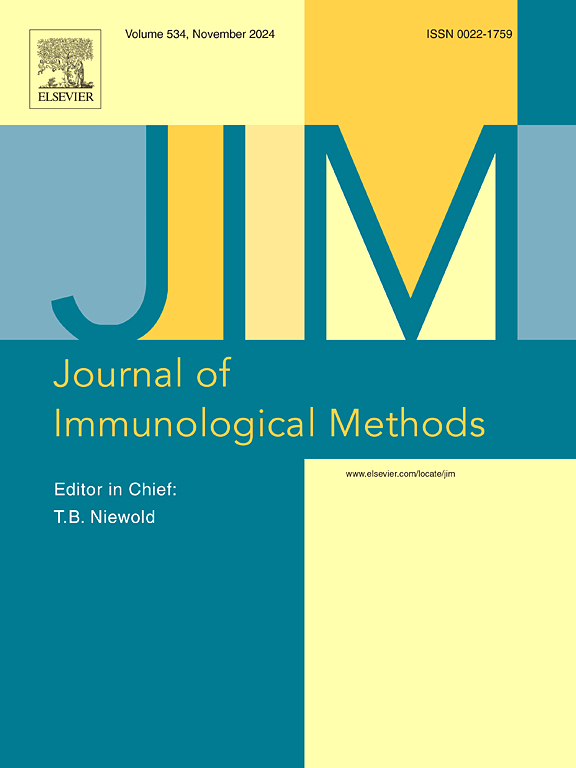Development of in vitro plaque-based assay for assessment of antibody-dependent enhancement in SARS-CoV-2 infection
IF 1.6
4区 医学
Q4 BIOCHEMICAL RESEARCH METHODS
引用次数: 0
Abstract
Antibody-dependent enhancement (ADE) of infection is a concerning phenomenon in SARS-CoV-2 infection, since it may develop disease severity. Although ADE has been demonstrated in animal models, the pathogenic mechanism has not been fully elucidated. The present study aimed to develop a simple assay system for detecting SARS-CoV-2 ADE activity in any antibody specimen. Vero E6/TMPRSS2/FcγRIIA, a Vero E6 cell strain expressing TMPRSS2 and FcγRIIA, was established. Seventeen plasma samples from convalescent patients and seven commercial antibodies were used as antibody specimens. Vero E6/TMPRSS2/FcγRIIA cells, infected with SARS-CoV-2 in the presence of antibody, were shown to exhibit ADE activity, with the plaque number increasing dramatically compared with the control in the absence of antibody specimens. Most plasmas displayed both ADE and neutralizing activities. Furthermore, 6 commercial antibodies recognizing structural proteins (membrane, nucleocapsid, envelope, and spike [transmembrane and cytoplasmic domains] proteins and non-structural protein ORF7) showed no potential ADE activity, while a commercial antibody recognizing spike RBD displayed ADE activity. These results indicate that antibodies possessing neutralizing and/or enhancing activity might be generated by either viral infection or vaccination. The present ADE assay may help to evaluate the risk of disease severity for individuals upon future reinfection, vaccination and/or immunotherapy.
基于体外空斑法评估SARS-CoV-2感染中抗体依赖性增强的建立
感染的抗体依赖性增强(ADE)是SARS-CoV-2感染中令人关注的现象,因为它可能发展为疾病严重程度。虽然ADE已在动物模型中得到证实,但其致病机制尚未完全阐明。本研究旨在开发一种简单的检测系统,用于检测任何抗体标本中的SARS-CoV-2 ADE活性。建立表达TMPRSS2和FcγRIIA的Vero E6细胞株Vero E6/TMPRSS2/FcγRIIA。采用恢复期患者血浆标本17份,商业抗体7份作为抗体标本。在抗体存在的情况下,感染了SARS-CoV-2的Vero E6/TMPRSS2/FcγRIIA细胞显示出ADE活性,在没有抗体的情况下,斑块数量比对照组显著增加。大多数等离子体同时显示ADE和中和活性。此外,6种识别结构蛋白的商业抗体(膜、核衣壳、包膜、刺[跨膜和细胞质结构域]蛋白和非结构蛋白ORF7)没有显示潜在的ADE活性,而识别刺突RBD的商业抗体显示ADE活性。这些结果表明,具有中和和/或增强活性的抗体可能由病毒感染或疫苗接种产生。目前的ADE检测可能有助于评估未来再感染、疫苗接种和/或免疫治疗后个体疾病严重程度的风险。
本文章由计算机程序翻译,如有差异,请以英文原文为准。
求助全文
约1分钟内获得全文
求助全文
来源期刊
CiteScore
4.10
自引率
0.00%
发文量
120
审稿时长
3 months
期刊介绍:
The Journal of Immunological Methods is devoted to covering techniques for: (1) Quantitating and detecting antibodies and/or antigens. (2) Purifying immunoglobulins, lymphokines and other molecules of the immune system. (3) Isolating antigens and other substances important in immunological processes. (4) Labelling antigens and antibodies. (5) Localizing antigens and/or antibodies in tissues and cells. (6) Detecting, and fractionating immunocompetent cells. (7) Assaying for cellular immunity. (8) Documenting cell-cell interactions. (9) Initiating immunity and unresponsiveness. (10) Transplanting tissues. (11) Studying items closely related to immunity such as complement, reticuloendothelial system and others. (12) Molecular techniques for studying immune cells and their receptors. (13) Imaging of the immune system. (14) Methods for production or their fragments in eukaryotic and prokaryotic cells.
In addition the journal will publish articles on novel methods for analysing the organization, structure and expression of genes for immunologically important molecules such as immunoglobulins, T cell receptors and accessory molecules involved in antigen recognition, processing and presentation. Submitted full length manuscripts should describe new methods of broad applicability to immunology and not simply the application of an established method to a particular substance - although papers describing such applications may be considered for publication as a short Technical Note. Review articles will also be published by the Journal of Immunological Methods. In general these manuscripts are by solicitation however anyone interested in submitting a review can contact the Reviews Editor and provide an outline of the proposed review.

 求助内容:
求助内容: 应助结果提醒方式:
应助结果提醒方式:


